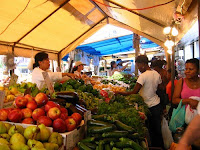Seasonal
Have you noticed that you can get fresh summer squash in the winter? Asparagus in the fall? Tomatoes year round? Sure, they may not be at their most flavorful, but many of the fruits and vegetables that we used to think of as seasonal delicacies are now available throughout much of the year, thanks to international shipping and modern growing techniques. I'm not saying this is a bad thing, asparagus is one of my passions, but I'm finding I miss the rhythm of seasonal foods. Now, when I find items that are only available in their own time, I embrace them, savor them, remember what it must have been like to be in awe of an orange in the toe of your stocking on Christmas morning.
I was reminded of this recently on a trip to Boston's Haymarket, our year-round open air produce and fish market. It's changed dramatically in the 20 years I've been shopping there (and I'm sure you can find essays that extoll it's glorious past and reduced present) but I love it. Everyone comes there, every age, ethnicity and economic status. Barkers call out to you to buy their tomatoes or avocados or celery. You can see the seasonal shift more readily there, not only by the dramatic price changes that are often disguised at the supermarket, but by the wonders you can find in the stands.
 On my last visit I happily bought asparagus and leeks, celery and parsley. Then I saw a stand with a display of lovely, small, green fuzzy things. I had no idea what they were. I asked the vendor who waved his English-speaking brother over. "Green almonds," he said. I asked him how to eat them and had nearly reached the limits of his English while I speak no Arabic. He cut one open and I saw a glistening, soft gem. "Boil in oil. With salt." I couldn't resist, bought a pound and brought it home.
On my last visit I happily bought asparagus and leeks, celery and parsley. Then I saw a stand with a display of lovely, small, green fuzzy things. I had no idea what they were. I asked the vendor who waved his English-speaking brother over. "Green almonds," he said. I asked him how to eat them and had nearly reached the limits of his English while I speak no Arabic. He cut one open and I saw a glistening, soft gem. "Boil in oil. With salt." I couldn't resist, bought a pound and brought it home.
 They are beautiful, clearly showing their kinship to peaches. The rind is soft and easy to cut and the seed inside doesn't need oil or salt or any addition beyond itself. They are pearl white, translucent and glistening when broken open, so very tender. It tastes of spring. It tastes green. It tastes of living earth and new life and the hope of a new year. It is the reminder of almonds as currency, as precious beyond compare, as the offering for a loved one or honored guest. I am in love, but I know this love is fleeting, because green almonds are utterly seasonal, gracing our tables for only a few weeks each year and infrequently found in New England.
They are beautiful, clearly showing their kinship to peaches. The rind is soft and easy to cut and the seed inside doesn't need oil or salt or any addition beyond itself. They are pearl white, translucent and glistening when broken open, so very tender. It tastes of spring. It tastes green. It tastes of living earth and new life and the hope of a new year. It is the reminder of almonds as currency, as precious beyond compare, as the offering for a loved one or honored guest. I am in love, but I know this love is fleeting, because green almonds are utterly seasonal, gracing our tables for only a few weeks each year and infrequently found in New England.
The ephemeral nature of this love makes it all the more sweet and as my mouth fills with the personification of the scent of grass I savor the fleeting moment, the reminder that time passes and spring, while brief, will come again.
(c) 2010 Laura S. Packer
I was reminded of this recently on a trip to Boston's Haymarket, our year-round open air produce and fish market. It's changed dramatically in the 20 years I've been shopping there (and I'm sure you can find essays that extoll it's glorious past and reduced present) but I love it. Everyone comes there, every age, ethnicity and economic status. Barkers call out to you to buy their tomatoes or avocados or celery. You can see the seasonal shift more readily there, not only by the dramatic price changes that are often disguised at the supermarket, but by the wonders you can find in the stands.
 On my last visit I happily bought asparagus and leeks, celery and parsley. Then I saw a stand with a display of lovely, small, green fuzzy things. I had no idea what they were. I asked the vendor who waved his English-speaking brother over. "Green almonds," he said. I asked him how to eat them and had nearly reached the limits of his English while I speak no Arabic. He cut one open and I saw a glistening, soft gem. "Boil in oil. With salt." I couldn't resist, bought a pound and brought it home.
On my last visit I happily bought asparagus and leeks, celery and parsley. Then I saw a stand with a display of lovely, small, green fuzzy things. I had no idea what they were. I asked the vendor who waved his English-speaking brother over. "Green almonds," he said. I asked him how to eat them and had nearly reached the limits of his English while I speak no Arabic. He cut one open and I saw a glistening, soft gem. "Boil in oil. With salt." I couldn't resist, bought a pound and brought it home. They are beautiful, clearly showing their kinship to peaches. The rind is soft and easy to cut and the seed inside doesn't need oil or salt or any addition beyond itself. They are pearl white, translucent and glistening when broken open, so very tender. It tastes of spring. It tastes green. It tastes of living earth and new life and the hope of a new year. It is the reminder of almonds as currency, as precious beyond compare, as the offering for a loved one or honored guest. I am in love, but I know this love is fleeting, because green almonds are utterly seasonal, gracing our tables for only a few weeks each year and infrequently found in New England.
They are beautiful, clearly showing their kinship to peaches. The rind is soft and easy to cut and the seed inside doesn't need oil or salt or any addition beyond itself. They are pearl white, translucent and glistening when broken open, so very tender. It tastes of spring. It tastes green. It tastes of living earth and new life and the hope of a new year. It is the reminder of almonds as currency, as precious beyond compare, as the offering for a loved one or honored guest. I am in love, but I know this love is fleeting, because green almonds are utterly seasonal, gracing our tables for only a few weeks each year and infrequently found in New England.The ephemeral nature of this love makes it all the more sweet and as my mouth fills with the personification of the scent of grass I savor the fleeting moment, the reminder that time passes and spring, while brief, will come again.
(c) 2010 Laura S. Packer



Comments
I am pretty much convinced that this is the same with most edible greens, therefore I try to buy regional stuff and only the fruits of the season. They taste better that way anyway.
(The only exception being winter, when there is hardly any fresh food to be had around here.)